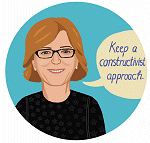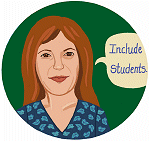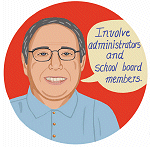Five on Five: A Dialogue on Profession Development
##AUTHORSPLIT##<--->
A quintet of educators gathers to soundoff on what works and what doesn't inthe ongoing mission to train teachers touse technology in classroom instruction.IN THE OLD DAYS, professional development didn'textend any further than the workshops teachers wouldattend to learn new applications. After the workshop, theteachers were on their own once they returned to schooland had to figure out how to use their new tools. Today,things are different. Technologies are too complex andthe need to integrate them into the classroom is too urgent toleave teachers unsupported. As part of a podcast series sponsoredby technology product supplier CDW-G,T.H.E. Journal contributing writer Matt Villano spoke with agroup of educators about the effort school systems are makingto help teachers with their technology needs, and what moreneeds to be done.
Four of the five panelists come from Pennsylvania, home of Classrooms for the Future, a massive reform project aimed at transforming the state's high schools through the use of instructional technology. An essential component of the initiative is its emphasis on providing professional development for teachers on how to use technology to advance learning. The Pennsylvania contingent included: Kristin Hokanson, technology integrator and Classrooms for the Future coach at Upper Merion Area High School in Montgomery County; Jim Gates, instructional technology trainer for the Capital Area Intermediate Unit 21, an educational service agency that works with school districts in a host of central Pennsylvania counties, and a Classrooms for the Future coach at Camp Hill High School; and Bob Keegan and Cathy Groller, executive director and assistant executive director, respectively, for Carbon Lehigh Intermediate Unit, an educational service agency that serves districts in Carbon and Lehigh counties.
The fifth member of the panel was Sylvia Martinez, president of Generation YES (Youth and Educators Succeeding), a provider of student-centered technology programs. Martinez kicked off the podcast with a summary of why the digital age has brought big changes to the consideration and implementation of professional development.
1 Why is ongoing professional development so important?
 Sylvia Martinez: In the old days, we looked to technology and thought, well, this is easy-we'll just teach teachers how to use this and everything will magically happen in the classroom. After all these years, we're realizing that doesn't work. Ongoing professional development doesn't mean we just teach more of the same or we do the same workshop over and over again. It's about listening to teachers as they work out the issues with technology. It's time spent giving feedback, collaborating, and building new skills on a solid foundation of what works.
Sylvia Martinez: In the old days, we looked to technology and thought, well, this is easy-we'll just teach teachers how to use this and everything will magically happen in the classroom. After all these years, we're realizing that doesn't work. Ongoing professional development doesn't mean we just teach more of the same or we do the same workshop over and over again. It's about listening to teachers as they work out the issues with technology. It's time spent giving feedback, collaborating, and building new skills on a solid foundation of what works.
Jim Gates: If you think of the alternative, which is not to have ongoing professional development, then the bar would have stopped five years ago with PowerPoint. Look at technologies such as RSS, wikis-none of that would be in schools if we'd just said, "Okay, we've reached the end." It's not a journey with an endpoint. It's ongoing.
2 What does each of you see as the most successful model for providing professional development?
 Martinez: I work with a lot of schools across the United States and I see a lot of different models. I don't think there's only one that works. I see success when professional development is taken seriously by administrators. Their support is crucial. Beyond that, constructivist techniques, when used in workshops, really work with teachers. The teachers want to get their hands on things and make them their own. Finally, I think support really has to be provided back in the classroom. Students can be part of this kind of last mile of classroom support that's so hard to provide and is so essential.
Martinez: I work with a lot of schools across the United States and I see a lot of different models. I don't think there's only one that works. I see success when professional development is taken seriously by administrators. Their support is crucial. Beyond that, constructivist techniques, when used in workshops, really work with teachers. The teachers want to get their hands on things and make them their own. Finally, I think support really has to be provided back in the classroom. Students can be part of this kind of last mile of classroom support that's so hard to provide and is so essential.
Kristin Hokanson: What's traditionally known as "spray and pray," where you give educators information and just hope that they're able to use it, hasn't been working. There is no one thing that works. I've been very impressed by how Classrooms for the Future tried to develop a model of professional development [that includes] coaches. The coaches are highly trained, and then they go out and work with their staff. Some vendors have also come and done out-of-the-box training with the teachers. Another part of our grant funding [required] that we have a student support team to inspire teachers to start changing their thinking. With this kind of support, we can see the kind of integrated use of technology that we really hope will benefit our students and prepare them for the 21st century.
Gates: We've stopped teaching the "click here, click there" method, and instead we bring teachers in with their laptops and we teach a lesson that happens to use one or two different computer applications so that we're modeling the classroom dynamic. When you're done with that, you see that each team in the room maybe created a slightly different product and each team learned the same material. Then we ask them, "How did you feel as a learner?" Teachers are learners, too, so instead of having them say, "I walked away knowing where to click," now they walk away knowing how to fashion an entire lesson.
Bob Keegan: At Carbon Lehigh, what we have found is that it isn't so much the focus on the technology itself, but instead the theory behind quality instruction. So we have focused on differentiated instruction and coaching as key areas that technology integration mentors need to know about before they can really affect instruction in the classroom. These mentors really have grown to be instructional leaders in their buildings and districts. Their focus is on technology and how to show teachers to use technology. But they're not techies, at least not anymore. They're integrators, and they're showing teachers how to integrate the technology into everyday lessons so that the technology almost becomes invisible. And what happens is that the kids get excited because they live in this arena-this is their world. When they see their teachers, whom they think are older and don't know about technology, using it in the classroom on a daily basis, it really changes the whole dynamic of instruction and learning.
3 Which types of teachers take to different professional development models better than others?
 Martinez: It's a myth that younger teachers are better with technology. And, in fact, when we work with teachers, we often see that the young teachers just don't have a comfort level yet to really add more things to their repertoires. They're still working on their own issues about being a teacher. You really have to be comfortable with project-based learning for technology to be successful. And teachers who have experience with running a project-based classroom are often able to make that transition very easily, no matter their ages.
Martinez: It's a myth that younger teachers are better with technology. And, in fact, when we work with teachers, we often see that the young teachers just don't have a comfort level yet to really add more things to their repertoires. They're still working on their own issues about being a teacher. You really have to be comfortable with project-based learning for technology to be successful. And teachers who have experience with running a project-based classroom are often able to make that transition very easily, no matter their ages.
Hokanson: Different people have different comfort levels, both for project-based learning and uses of technology. I can't really say that you can define who those teachers are, but I can say that, just as we want differentiated instruction for our children, we need to drive that same type of differentiation for our teachers. We need to listen to what their needs are, we need to think about what their strengths and weaknesses are, and we need to design for them professional development that will meet the needs in their classrooms. One of the things that I found very effective with my teachers is going in and saying to them, "What are the things that are working very well for you?" I ask them, "Where are the places that you have concerns?" If I know the things that are working and I know where teachers have concerns, then I can work with them on the things that are going to make a difference within their classrooms.
Gates: I'm finding that the veteran teachers are just pretty comfortable [with technology training]. For one thing, they adapt to these things a lot faster.
Cathy Groller: When you use the word technology, it addresses the efficacy of the people you're teaching. And so, for those who are still afraid of technology, it creates a level of fear, and you start with an obstacle before you've even begun in your training. Knowing that, we have to always keep in mind that we're dealing with adult learners who have a different set of skills.
4 Moving forward, what do you see as the biggest challenges to professional development?
 Martinez: There are obstacles to [overcome] in every organization. Schools aren't unique in that way. People like their comfort zones-that's why they're called comfort zones. What we try and do is create success, and then show that success to other people. I think, a lot of times, we're building a wall between professional development and what actually happens in a classroom. For some teachers, unless they see it with students, they're never going to believe it. They can build a project in a workshop, but then they don't quite believe that students are actually going to be able to do it. So we need to move professional development to a place where students are actually participating, and participating in an important way, to show teachers how students use technology.
Martinez: There are obstacles to [overcome] in every organization. Schools aren't unique in that way. People like their comfort zones-that's why they're called comfort zones. What we try and do is create success, and then show that success to other people. I think, a lot of times, we're building a wall between professional development and what actually happens in a classroom. For some teachers, unless they see it with students, they're never going to believe it. They can build a project in a workshop, but then they don't quite believe that students are actually going to be able to do it. So we need to move professional development to a place where students are actually participating, and participating in an important way, to show teachers how students use technology.
Hokanson: Exactly. We need to help teachers see that we are providing them the professional development to learn these tools in the same way that the students are learning them, and I think that the students can be great models for that. We use wikis and MySpace a lot with our teachers, and the students know how to change their pictures and do all the things that the teachers want to be able to do. Let the kids show them how. Listen to the kids.
Gates: In the school I'm with, I don't see any resistance to the desire to learn. What I see as the biggest obstacle is time. Our teachers are under contract for 188 days, and when you take away the day before school starts, the day after school [ends], and a few other days here and there, you're down to six days left for professional development. So it isn't that teachers don't want to learn this stuff. It's more a question of, when are we going to make this happen?
Keegan: We can't forget about the administrators and the school board members. Administrators are hugely powerful. If they model the use of technology in their presentations to their staff, if they model the use of technology in school board meetings, in budget presentations to the community, they have a chance to grab the interest of parents. And above all, they get school board members into the schools to see how the technology's being used and how it can affect student learning. I think that's unbelievably powerful because those school board members, let's face it: A lot of them are of the older generation. They're the ones making the money decisions about providing the resources for these things to occur, and I think that's a critical piece of the puzzle.
Hokanson: I want to tell a great story of something that happened at our school. One day, members of our local senior center wanted to come in and see what we were doing. They came, and by the time they were finished with their day, they were amazed at the Smart Board and other technologies we were using to teach kids visually to understand concepts that were so abstract. So I think opening the schools and making them a little more transparent is a really good idea
5 What will professional development look like three to five years from now?
 Martinez: The trend that's really going to make the difference is just the amount of technology in schools. People are bringing in all kinds of technology. I think it's going to push us to realize that students have to be included more in professional development because it's impossible to keep trying to funnel this through teachers and hope it trickles down. It just doesn't make sense to give every student a laptop, and then only teach the teachers how to use those laptops in educational ways. Students are 92 percent of the population in schools. We've got to start thinking of them as these incredible, eager, willing partners who really want to help. This is what it means to be a citizen of the 21st century, where everyone's learning, contributing, communicating, and collaborating.
Martinez: The trend that's really going to make the difference is just the amount of technology in schools. People are bringing in all kinds of technology. I think it's going to push us to realize that students have to be included more in professional development because it's impossible to keep trying to funnel this through teachers and hope it trickles down. It just doesn't make sense to give every student a laptop, and then only teach the teachers how to use those laptops in educational ways. Students are 92 percent of the population in schools. We've got to start thinking of them as these incredible, eager, willing partners who really want to help. This is what it means to be a citizen of the 21st century, where everyone's learning, contributing, communicating, and collaborating.
Hokanson: I agree, we need to get people connected. Too often, we are working to meet the needs of school initiatives, and we're not looking at individual needs of teachers and connecting them with like-minded people so they can have more individualized learning in an area of support that they need. Either via webinars, virtual environments, or learning management systems, I see this notion of interconnectedness as a growing trend.
Gates: Another immediate change I'd like to see would be that the people who are preparing the workshops will shift from training talks to talking about the actual impact in the classroom. The chatter needs to change from "What did you learn at the end of this day?" to "Did you see how this tool can help your students learn?"
Groller: I see two major changes. First, one of the things that we recently recognized was a resource that's staring us in the face: our students. We created a program called Tech Wizard, where we work with a group of sixth-grade students and advisers and train them on technology integration. Their role is to return to their school districts and be responsible for the professional development of the teachers and administrators within those districts. We have found that the kids are extremely excited. Like it or not, they're a generation ahead of us in their technology understanding. A second change would be that we look at professional development and couch it in a framework of curriculum. I mean that we don't teach technology in isolation, but rather teach it in alignment with differentiated instruction and project-based learning. It's critical to keep professional development in a constructivist approach. Otherwise, it's not development at all.
::WEBEXTRAS ::
To access the entire podcast of this interview, visithere.
Matt Villano is a freelance writer based in Healdsburg, CA.